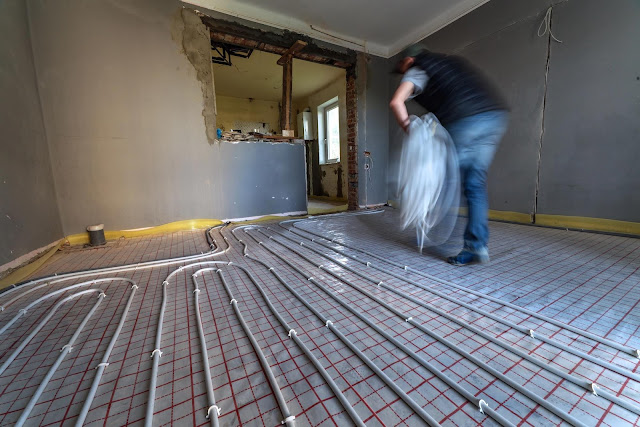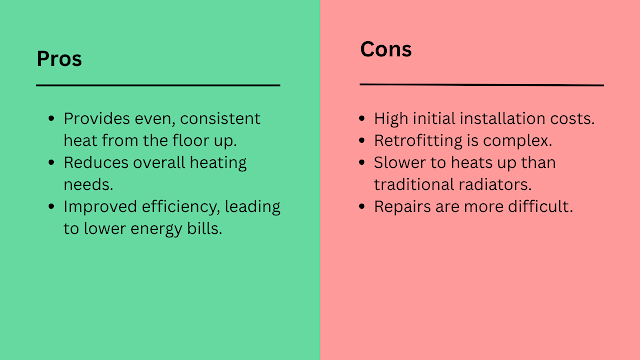How does underfloor heating work? (Is it worth installing?)
Underfloor heating is becoming an increasingly popular choice for homeowners in the UK looking for an efficient and comfortable way to heat their homes. But what exactly is underfloor heating, and how does it work? Is it worth the investment?
What is Underfloor Heating?
Underfloor heating is a method of heating your home that operates by running heating installations under the floor. Because it works by heat radiation instead of convection, it provides more efficient heat compared to traditional radiators. It's a discreet and effective way to evenly distribute heat throughout a room, offering a comfortable and consistent temperature. This means no more cold spots or relying on radiators to blast heat unevenly across the space, as the heat radiates from the floor.
How does Underfloor Heating Work?
Underfloor heating works by warming the floor, which then radiates heat upwards, distributing warmth evenly throughout the room and creating a consistent temperature. An underfloor heating system uses either a network of pipes carrying hot water or electric wires installed beneath the floor surface, effectively transforming the entire floor into a large, efficient heat emitter. Unlike radiators, which use convection to heat the air, underfloor heating uses radiant heat, which warms objects and people directly, improving efficiency and providing a more comfortable and natural warmth.
Types of Underfloor Heating Systems
There are two main types of underfloor heating systems available in the UK: electric and water-based. Electric underfloor heating systems, often referred to as 'dry' systems, use electric heating mats or wires to generate heat. These electric underfloor heating systems are typically easier to install, especially in smaller areas like a bathroom, and are ideal for retrofitting into existing homes. On the other hand, a water underfloor heating system, also known as a 'wet' system, connects directly to your central heating system. It circulates warm water through a network of underfloor pipes to heat the floor. Depending on the shape of the room, you can opt for heating mats that cover large areas efficiently, or individual wires which can be more easily fitted around tricky angles. Both systems provide efficient heat, but they differ in their installation process and energy consumption. Remember, the type of floor is important when considering an underfloor heating system. Tile, stone and concrete are the best materials to use with underfloor heating.
Electric vs Water Underfloor Heating
Choosing between an electric and a water underfloor heating system depends on your specific needs and circumstances. Both are fantastic solutions, but they each excel in different scenarios. The initial cost to install electric underfloor heating is generally lower, making it an attractive option for smaller budgets. However, the costs associated with running an electric underfloor heating system are significantly higher compared to a wet underfloor heating system due to the higher price of electricity. A wet underfloor heating system linked to a modern boiler can cut heating costs by an estimated 25% compared to radiators, while pairing it with a heat pump could save you up to 40%.
Electric Underfloor Heating Explained
Electric underfloor heating, or dry underfloor heating, comprises electric heating mats or cables strategically placed beneath the floor. When electricity flows through these components, they generate efficient heat that radiates upwards, effectively warming the room. This electric underfloor heating system is particularly well-suited for swiftly heating smaller spaces like bathrooms, where comfort underfoot is a priority. Because electric underfloor heating uses electricity directly, this type of heating can be costly compared to other alternatives. The system typically includes a heating wire connected to the mains electrics and is a good option for small rooms that you don't need to heat for long periods of time.
Water Underfloor Heating System Overview
Water underfloor heating systems, also known as wet underfloor heating systems, utilise a network of underfloor pipes laid beneath the floor's surface. These underfloor pipes connect to a central heating system source, such as a boiler or heat pump, which circulates warm water through the pipes. As the warm water flows, it efficiently heats the floor, which then radiates warmth into the room above. This type of underfloor heating uses a larger surface area than radiators, allowing you to efficiently heat your home using a water underfloor heating system at lower boiler or heat pump flow temperatures. The subfloor will hold a network of pipes running heated warm water across your floor.
Comparing Electric and Wet Underfloor Heating
When comparing electric underfloor heating and wet underfloor heating systems, the initial cost is one key factor. Generally, electric systems are cheaper to install than water systems, but they are more expensive to run in the long term. While wet underfloor heating systems are an extremely efficient and effective whole-house heating solution when paired with a bespoke design, they require a larger upfront investment to install. This means carefully considering your budget, long-term running costs, and the area you want to heat before deciding on the best type of underfloor heating for your needs.
Installation of Underfloor Heating
The underfloor heating installation process requires precision and expertise to ensure optimal performance and longevity of the system. Whether you opt for an electric or wet system, it's important to recognise that installing these types of underfloor heating systems can be complex. Therefore, it's strongly advised that you install underfloor heating with qualified professionals. Attempting a DIY installation could lead to inefficiencies, damage, or even safety hazards, making professional installation a worthwhile investment. Make sure your installer knows what they are doing, and ask for references.
What to Expect in the Underfloor Heating Installation Process
The underfloor heating installation process varies slightly depending on whether you choose a wet or electric system. For a wet underfloor heating system, the installer needs to connect the underfloor pipes to a boiler or heat pump. If you're getting underfloor heating as part of a heat pump installation, the installer will consider this as part of the overall design to ensure compatibility and efficiency. In contrast, a qualified electrician needs to connect a dry electric system to the power supply. Remember that heating controls can then be installed for either system. All electrics should be fully tested before signing off on the work. All work should be certified by a qualified person.
How much does it cost to install Underfloor Heating?
According to Checkatrade, the average installation costs per square metre are:
- Dry (electric system): £50 to £85/m²
- Wet (water system): £85 to £110/m².
You can save on costs if you're already renovating your home, particularly if you're already replacing the type of floor. An electric system will cost around £75 per square metre for pre-fitted heating mats, or £100 per square metre for the loose cables. Water systems will cost significantly more, with total costs after installation running into thousands of pounds.
What does Underfloor Heating cost to run?
Some studies have shown that underfloor heating can be up to 25% more efficient than traditional radiators, potentially leading to significant savings on heating costs. Although the exact figure you'll save depends on the type of system (electric or water), the size of the area you're heating, your insulation levels, and your energy tariff. While the initial cost of installation might be higher, the long-term running costs are be competitive, especially with a wet underfloor heating system connected to an efficient boiler or heat pump. Electric underfloor heating generally costs more to run due to the higher price of electricity compared to gas.
To further save money on energy costs you could look at installing a solar heating system, smart meter or smart thermostat.
Pros & Cons of Underfloor Heating
The fact that underfloor heating heats the room from the floor up provides a more even and consistent termrature, leading to a comfortable warm enviroment and eliminating cold spots compared to standard radiators. Because it has a consistent temperature, you can find that you don't need to heat your home as much as you used to. Underfloor heating is more efficient at heating rooms saving you money on your nergy bills.
There are a few drawbacks to underfloor heating, most notably the initial installation cost, which can be considerably higher than traditional heating systems. More over, retrofitting underfloor heating in an existing property can be complex and disruptive, often requiring extensive floor modifications. Another drawback is the time it takes for underfloor heating systems to warm up compared to conventional radiators, meaning it takes longer for a room to reach the desired temperature. Lastly, if a fault occurs, repairs can be challenging and costly, as the system is typically embedded within the flooring, making access difficult. Although it's uncommon to have issues with a system correctly fitted by a qualifyed installer.
Conclusion: Is Underfloor Heating Worth Installing?
At the end of the day, deciding if an underfloor heating system is worth it depends on your individual circumstances and preferences. It can be costly to install, but the long-term benefits, such as energy efficiency, comfort, and space-saving design, can make it a worthwhile investment for many UK homeowners. If your considering underfloor heating in your home, I highly recomend seeking the advice of a qualifyed installer, who can advise you on the best solution for your needs.





Comments
Post a Comment